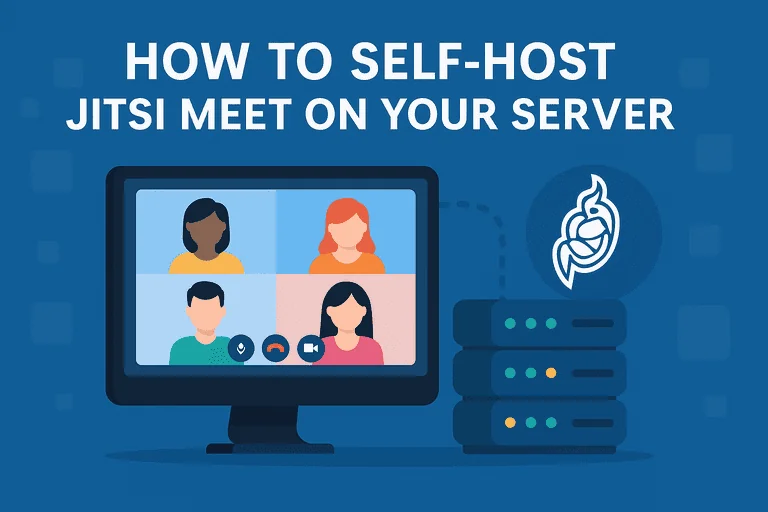Introduction
Want secure, high-quality video calls without Big Tech in the middle? Jitsi Meet is a powerful, open-source video conferencing solution you can fully self-host. It’s ideal for teams, communities, or individuals who care about privacy and control.
Who is this for?
- Privacy-focused users
- Educators, teams, or remote workers
- Anyone tired of Zoom, Teams, or Google Meet
What you’ll get:
- A self-hosted Jitsi Meet instance
- HTTPS-secured access
- Optional authentication and performance tuning
Why Choose Jitsi Meet?
| Feature | Jitsi Meet (Self-Hosted) |
|---|---|
| Video Conferencing | Yes (1-on-1 and group) |
| Privacy | Full control, no 3rd party tracking |
| Encryption | Encrypted in transit |
| Screen Sharing | Yes |
| Recordings | Yes (with additional setup) |
| Authentication | Optional (JWT, LDAP, secure rooms) |
Jitsi Meet is built for privacy and performance. Unlike Zoom or Google Meet, it doesn’t require an account and can be fully hosted on your own infrastructure.
Requirements
- Ubuntu 20.04/22.04 VPS or local server (2+ vCPU, 4+ GB RAM recommended)
- Root SSH access
- A domain (e.g.
meet.example.com) - Ports 80, 443 (HTTPS), and optionally 10000/UDP open
Installation Options
You can install Jitsi Meet via:
- Official Debian packages (recommended)
- Docker (community-maintained, more complex)
This guide uses the Debian package method on Ubuntu.
Step-by-Step Setup (Debian Packages)
1. Configure System Hostname
sudo hostnamectl set-hostname meet
sudo apt update && sudo apt upgrade -y2. Add Jitsi Repository
sudo apt install gnupg2 curl -y
curl https://download.jitsi.org/jitsi-key.gpg.key | sudo gpg --dearmor -o /usr/share/keyrings/jitsi-keyring.gpg
echo "deb [signed-by=/usr/share/keyrings/jitsi-keyring.gpg] https://download.jitsi.org stable/" | sudo tee /etc/apt/sources.list.d/jitsi-stable.list3. Install Jitsi Meet
sudo apt update
sudo apt install jitsi-meet -yDuring installation, you’ll be prompted:
- Enter your domain (e.g.
meet.example.com) - Choose to generate a self-signed or Let’s Encrypt certificate
4. (Optional) Enable Let’s Encrypt
If you skipped Let’s Encrypt during install:
sudo /usr/share/jitsi-meet/scripts/install-letsencrypt-cert.shFollow prompts to secure your site with HTTPS.
Optional Configurations
Secure Room Access
Prevent uninvited guests:
sudo nano /etc/prosody/conf.avail/meet.example.com.cfg.luaChange authentication method:
authentication = "internal_plain"Then run:
sudo prosodyctl register YOURUSER meet.example.com YOURPASSWORDFirewall Configuration
sudo ufw allow 22/tcp
sudo ufw allow 80,443/tcp
sudo ufw allow 10000/udp
sudo ufw enableAccess and Use
- Open https://meet.example.com in your browser
- Start a meeting (no sign-in required unless you enable auth)
- Mobile: Use the Jitsi Meet mobile app and connect to your server under “Advanced Settings”
FAQs
Q: Does Jitsi support recording?
A: Yes, but it requires additional setup using Jibri or Dropbox integration.
Q: Is it scalable?
A: For a few dozen users, a single server suffices. For large meetings, consider setting up Jitsi VideoBridges.
Q: How is it different from Zoom or Google Meet?
A: Jitsi is 100% open-source, self-hostable, and doesn’t collect user data.
Final Thoughts
Self-hosting Jitsi Meet gives you full control over your video calls—without sacrificing usability. It’s reliable, scalable, and secure.
Your meetings. Your server. Your rules.
Support SelfhostHero: Share this guide, contribute to the project, or use our affiliate tools to keep independent tech alive.

